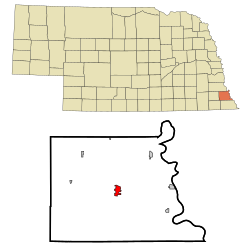
Richardson County is the easternmost county in the U.S. state of Nebraska. As of the 2020 census, the population was 7,871. Its county seat is Falls City.

Pawnee County is a county in the U.S. state of Nebraska. As of the 2020 United States Census, the population was 2,544. Its county seat is Pawnee City.

Nemaha County is a county in the U.S. state of Nebraska. As of the 2020 United States Census, the population was 7,074. Its county seat is Auburn.

Johnson County is a county in the U.S. state of Nebraska. As of the 2020 United States Census, the population was 5,290. Its county seat is Tecumseh. The county was formed in 1855, and was organized in 1857. It was named after Richard Mentor Johnson, who was Vice President of the United States from 1837 to 1841.

Nemaha County is a county located in the northeastern part of the U.S. state of Kansas. Its county seat is Seneca. As of the 2020 census, the county population was 10,273. The county was named for the Nemaha River.

Nemaha is a city in Sac County, Iowa, United States. The population was 66 at the time of the 2020 census.

Seneca is a city in and the county seat of Nemaha County, Kansas, United States. As of the 2020 census, the population of the city was 2,139.

New Auburn is a city in Sibley County, Minnesota, United States. The population was 456 at the 2010 census.

Burwell is a city in Garfield County, Nebraska, United States. The population was 1,210 at the 2010 census. It is the county seat of Garfield County.

Cook is a village in Johnson County, Nebraska, United States. The population was 323 at the 2020 census.

Brock is a village in Nemaha County, Nebraska, United States. The population was 122 at the 2020 census.

Brownville is a village in Nemaha County, Nebraska, United States. The population was 142 at the 2020 census.

Johnson is a village in Nemaha County, Nebraska, United States. The population was 313 at the 2020 census.

Julian is a village in Nemaha County, Nebraska, United States. The population was 48 at the 2020 census.

Nemaha is a village in Nemaha County, Nebraska, United States. The population was 116 at the 2020 census.

Peru is a city in Nemaha County, Nebraska, United States. The population was 648 at the 2020 census. Peru State College is located in Peru.

Burr is a village in Otoe County, Nebraska, United States. The population was 52 at the 2020 census.

Lorton is a village in Otoe County, Nebraska, United States. The population was 35 at the 2020 census.

Barada (pronounced as Bear uh duh) is a village in northeast Richardson County, Nebraska, United States. The population was 20 at the 2020 census.

Seward is a city and county seat of Seward County, Nebraska, United States. The population was 6,964 at the 2010 census. Seward is part of the Lincoln, Nebraska Metropolitan Statistical Area.






















